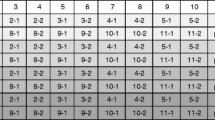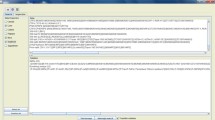Abstract
The international working group “Development of methods for identification of foodstuffs produced by means of genetic engineering techniques” was established pursuant to § 64 of the German Food and Feed Code (LFGB). It has developed a guideline for implementing and verifying digital PCR methods previously validated as real-time PCR techniques. While event-specific methods in testing of genetically modified organisms (GMO) have traditionally relied on real-time PCR, new digital PCR technologies offer significant advantages and therefore, leading to an increased use by control laboratories. This guideline provides practical recommendations for transferring the real-time PCR to digital PCR and for verifying the digital PCR method. The guideline is applicable to analysis of GMO in food, feed and seed and is freely available on the website of the Federal Office of Consumer Protection and Food Safety (BVL).
Similar content being viewed by others
Avoid common mistakes on your manuscript.
1 Introduction
For authorization of GMO and derived food and feed products, the European legislation mandates validated event-specific methods for their detection, identification and quantification (European Parliament and the Council 2003). Footnote 1 The EU legislation (European Commission 2013) further provides criteria for appropriate methods of GMO testing, specifically referencing the analytical requirements established as common criteria by the EU Reference Laboratory for Genetically Modified Food and Feed (EURL GMFF) and the European Network of GMO Laboratories (ENGL) – the minimum performance requirements (MPR) (European Network of GMO Laboratories 2015; Gatto et al. 2023). Event-specific methods have to be developed by the applicant and are carefully validated by the EURL GMFF in collaboration with the ENGL as an integral component of the official authorization process. To date, the EURL GMFF has published 170 method validation reports (so-called ‘dossiers’) on its website, however, all methods have been developed and validated using real-time PCR (qPCR).
The working group “Development of methods for identification of foodstuffs produced by means of genetic engineering techniques”, established pursuant to § 64 of the German Food and Feed Code, compromises experts from official control, scientific institutions, and industry. Their primary task is to review developed methods and assess their applicability, suitability, performance, reliability, and comparability for official control. In general, interlaboratory method validation studies are carried out and evaluated by using statistical methods. Additionally, the working group also prepares scientific guidelines for the harmonization of GMO analysis practices.
1.1 Analytical and technological developments required new guidelines
In recent years, digital PCR (dPCR), including both droplet digital PCR (ddPCR) and chamber digital PCR (cdPCR), has emerged as a promising technology in various analytical fields where quantification of nucleic acid target sequences is required, particularly in GMO control. Its efficacy has been demonstrated e.g. in proficiency tests and other applications. The main advantages of digital PCR are its independence from external calibration standards, reduced susceptibility to PCR inhibitors and improved accuracy (Pecoraro et al. 2019). Laboratories have thus been faced with the challenge of verifying whether official methods for GMO testing, initially validated in real-time PCR format, maintain their analytical performance when transferred to the digital PCR format. Consequently, there was an urgent need for recommendations on the extent to which digital PCR methods should undergo analytical verification in order to meet the minimum performance requirements, while also considering a harmonized approach for the scientific community when dealing with accreditation bodies. Therefore, the international working group “Development of methods for identification of foodstuffs produced by means of genetic engineering techniques” established a dedicated sub-working group in 2022 to develop a scientific guideline for dPCR verification. The sub-working group concluded its work and published the guideline in 2023 (§ 64 LFGB WG „GMO detection“ 2024).
2 Initial validation of the digital PCR system
Prior to the first verification of dPCR methods, it is generally recommended to perform an initial validation of the instrument system. This should include an assessment of sensitivity, trueness and precision. Additionally, the analysis of linearity, dynamic range and robustness of the dPCR instrument system should be performed by using a representative method. Reference materials certified for absolute copy number concentrations are particularly well-suited for this purpose. However, it is important to consider the reaction volume of each partition, along with any associated uncertainty. During subsequent verifications of dPCR methods, there is no need to reevaluate the linearity and robustness for each individual method.
2.1 Maintained and adjusted reaction conditions during transfer from real-time PCR to dPCR
When converting and verifying a validated qPCR method into a dPCR method, not all reaction conditions can be strictly adopted due to technical reasons. Some reaction conditions, e.g., primer/probe sequences, concentrations, and annealing temperature, should be maintained. If there are (substantial) deviations that were not tested during the initial qPCR validation study, a validation of the dPCR method is recommended. Other conditions, such as probe labelling, number of PCR cycles, choice of reference gene method, and device-specific master mix and reaction volume, can be adjusted if necessary without additional validation. This approach ensures flexibility for the laboratory while maintaining the method’s reliability.
2.2 Performance criteria for digital PCR verification
Provided that the underlying qPCR method has already been fully validated in the real-time PCR format and that the dPCR system in general has been initially validated, the following performance characteristics should be investigated during dPCR verification in order to meet the minimum performance requirements for GMO analysis (Gatto et al. 2023). Firstly, resolution and rain should be examined in the dPCR plot to ensure the accuracy of the method. The sensitivity of the dPCR method should be confirmed with 10 PCR replicates showing that the limit of detection (LOD) or the limit of quantification (LOQ) meets the established acceptance criteria for detection methods in GMO analysis, i.e. 20 copies per PCR for qualitative methods or 50 copies per PCR for quantitative methods. To ensure precision and accuracy, it is recommended to test at least 2 independent DNA extracts from 2 certified reference materials, if available. This requires a minimum of 16 PCR replicates per reference material (or GMO concentration) to be analysed in at least 2 independent series of measurements. Robustness and specificity, on the other hand, do not need to be tested when verifying dPCR methods, as the molecular biological principle of the method is not changed if the most important reaction conditions are maintained and undesired non-specific amplifications are usually visible in the dPCR plots.
2.3 Validation of duplex dPCR for transgene and reference gene quantification
Currently, event-specific methods have only been validated by the EURL GMFF as singleplex real-time PCR methods, meaning that the transgene and the reference gene sequence are analysed separately. However, for practical and economic reasons, it may be preferable to analyse both sequences in a duplex format for routine analysis. Therefore, the guidelines provide additional recommendations for validation as a duplex dPCR method. Validation by only one or two laboratories should be sufficient to demonstrate the suitability and equivalence of the modified method, allowing further laboratories to verify the methods against these guidelines.
3 Quality management and accreditation
Due to the close relationship between real-time PCR and dPCR, pragmatic approaches that ensure flexibility in terms of quality management and accreditation are supported. For example, dPCR methods can be included in an existing accreditation of real-time PCR methods, even within the same testing field. Since some modifications of the real-time PCR method are necessary during dPCR verification due to technical reasons, we recommend classifying it as an ‘in-house method’. This classification favours the regular inclusion of such verified methods in the laboratory’s scope of methods under flexible accreditation.
4 Conclusion
The guideline for the verification of methods using digital PCR provides a comprehensive overview of the requirements and practical considerations for GMO testing. Using this guideline, laboratories should be able to transfer real-time PCR methods to digital PCR while meeting internationally accepted minimum performance requirements of the EURL GMFF and ENGL. The guideline is freely available on the website of the Federal Office of Consumer Protection and Food Safety (§ 64 LFGB WG „GMO detection“ 2024).
References
§ 64 LFGB WG „GMO detection" (2024) Guidelines for the verification of methods using digital PCR. https://www.bvl.bund.de/SharedDocs/Downloads/07_Untersuchungen/Guidelines_for_the_verification_of_methods_using_digital_PCR.html. Accessed 2024
Commission Implementing Regulation (EU) No 503/2013 of 3 April (2013) on applications for authorisation of genetically modified food and feed in accordance with Regulation (EC) No 1829/2003 of the European Parliament and of the Council and amending Commission Regulations (EC) No 641/2004 and (EC) No 1981/2006: Document 32013R0503. L 157, 8.6.2013
European Network of GMO Laboratories (2015) Definition of Minimum Performance requirements for Analytical methods of GMO Testing. JRC95544. Publications Office of the European Union Luxembourg
Gatto F, Savini C, Baillie C-K, Broothaerts W, Burns M, Dagand E, Debode F, Dobnik D, Grantiņa-leviņa L, Grohmann L, Lieske K, Marchesi U, Marien A, Mazzara M, Papazova N, van der Berg JP, Verginelli D, Zdeňková K (2023) Definition of minimum performance requirements for analytical methods of GMO testing- part 2. JRC 125975. Publications Office of the European Union, Luxembourg
Pecoraro S, Berben G, Burns M, Corbisier P, de Giacomo M, de Loose M, Dagand E, Dobnik D, Eriksson R, Holst-Jensen A, Kagkli D-M, Kreysa J, Lievens A, Mäde D, Mazzara M, Paternò A, Peterseil V, Savini C, Sovová T, Sowa S, Spilsberg B (2019) Overview and recommendations for the application of digital PCR. JRC technical reports, EUR 29673 EN, JRC 115736. Publications Office of the European Union, Luxembourg
Regulation (EC) (2003) No 1829/2003 of the European Parliament and of the Council of 22 September on genetically modified food and feed: Document 32003R1829. L 268, 18.10.2003
Funding
Open Access funding enabled and organized by Projekt DEAL.
Author information
Authors and Affiliations
Corresponding author
Ethics declarations
Conflict of interest
The authors declare that they have no conflict of interest.
Additional information
Publisher’s Note
Springer Nature remains neutral with regard to jurisdictional claims in published maps and institutional affiliations.
Rights and permissions
Open Access This article is licensed under a Creative Commons Attribution 4.0 International License, which permits use, sharing, adaptation, distribution and reproduction in any medium or format, as long as you give appropriate credit to the original author(s) and the source, provide a link to the Creative Commons licence, and indicate if changes were made. The images or other third party material in this article are included in the article’s Creative Commons licence, unless indicated otherwise in a credit line to the material. If material is not included in the article’s Creative Commons licence and your intended use is not permitted by statutory regulation or exceeds the permitted use, you will need to obtain permission directly from the copyright holder. To view a copy of this licence, visit http://creativecommons.org/licenses/by/4.0/.
About this article
Cite this article
Weidner, C., Frenzel, J., Bartsch, D. et al. Guideline for the verification of digital PCR methods in analytical GMO testing. J Consum Prot Food Saf (2024). https://doi.org/10.1007/s00003-024-01516-6
Received:
Revised:
Accepted:
Published:
DOI: https://doi.org/10.1007/s00003-024-01516-6




